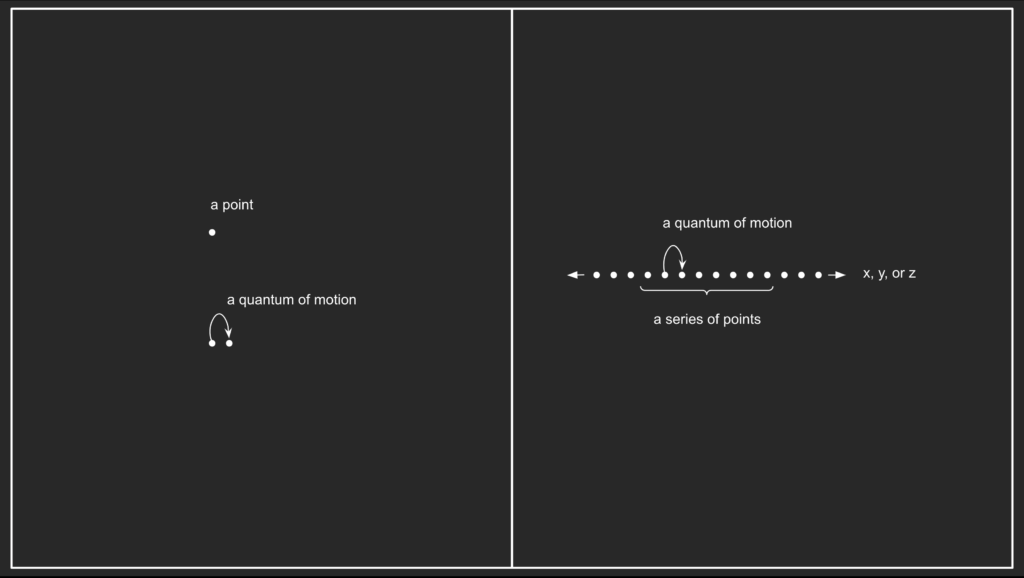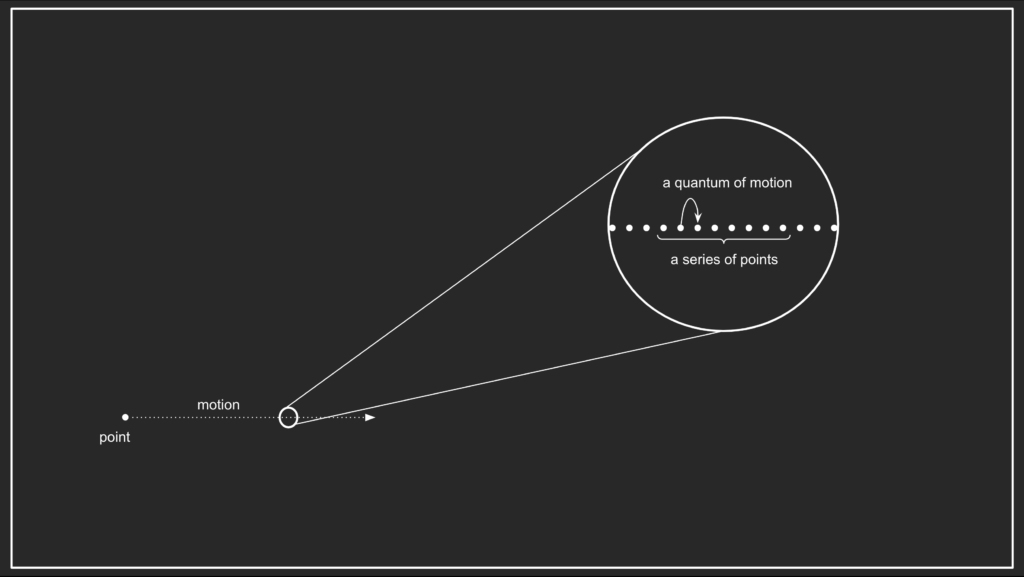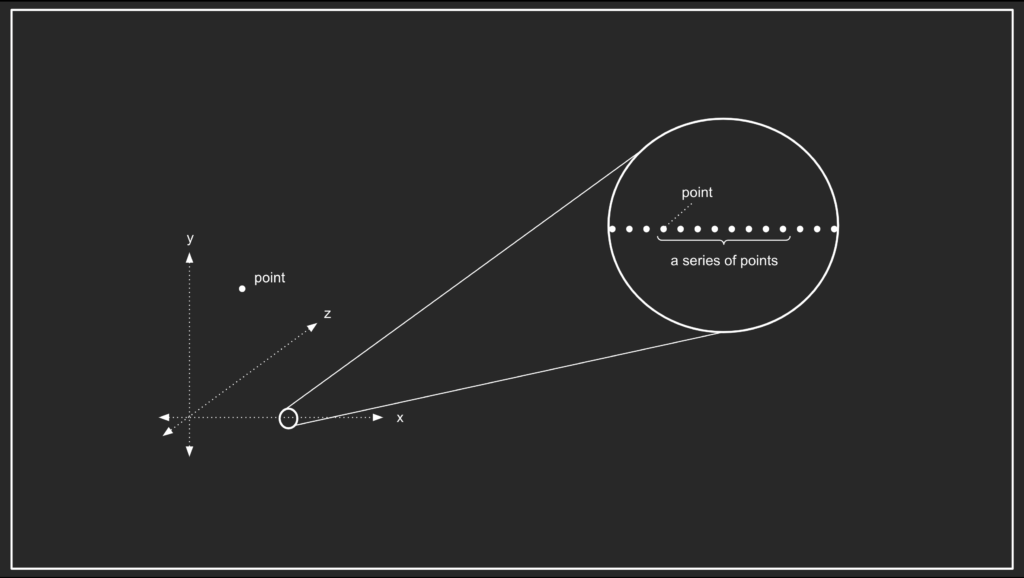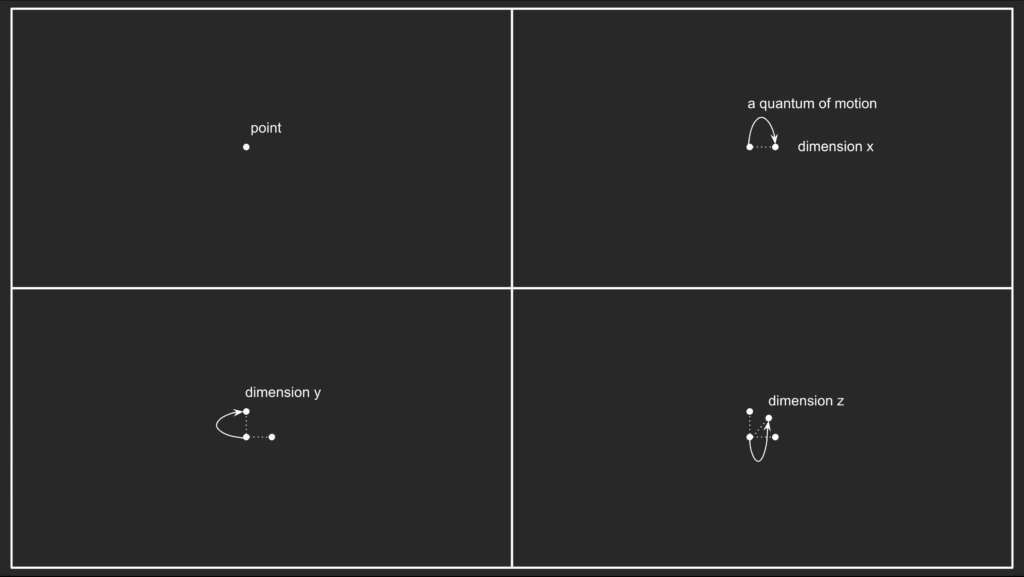1. The Point and Motion Are Dimensions in Space
The point [1] [2] is a fundamental building block of dimensions [3] x, y, and z.
X, y, and z can only exist if the point can exist in different positions [4] to form them.
Motion [5] is necessary for the point to change position.
This means motion is also a building block of x, y, and z.
If the point and motion are building blocks of dimensions x, y, and z, then the point and motion are dimensions in space [6].

2. The Point and Motion Are The Fundamental Dimensions in Space
The point and motion are dimensions in space.
The point has no substructure because there is no way of deconstructing it further.
A quantum of action [7] [8] [9] has no substructure because there is no way of deconstructing it further.
A quantum of action is a quantum of motion.
Therefore, the point and motion are the fundamental [10] [11] dimensions in space.

3. X, Y, and Z Are Composite Dimensions as They Are Made of a Series of Points
The point has no substructure, therefore is a fundamental dimension.
Dimensions x, y, and z are made of a series of points.
Therefore, x, y, and z are composite [12] [13] dimensions made of points.

4. The Five Dimensions Are the Product of Two Dimensions
The five observable dimensions in space are:
– Point
– Motion
– x
– y
– z
X, y, and z are composite dimensions made of points.
Points produce dimensions by motion.
The point and motion are fundamental dimensions.
Therefore, there are only two dimensions in space: The point and motion.

5. How the Point and Motion Create Space
When all points are in a single position, space does not exist [14] [15].
Points change position by motion.
When a point changes position it creates dimension x.
When another point changes position perpendicular or oblique to dimension x, then it creates dimension y.
When another point changes position perpendicular or oblique to the x-y plane [16], then it creates dimension z.
When dimensions x, y, and z exist, then space exists.

References and Notes
[1] Field (physics) – by Wikipedia: https://en.wikipedia.org/wiki/Field_(physics)
[2] Point particle – by Wikipedia: https://en.wikipedia.org/wiki/Point_particle
[3] Dimension – by Wikipedia: https://en.wikipedia.org/wiki/Dimension
[4] Position (geometry) – by Wikipedia: https://en.wikipedia.org/wiki/Position_(geometry)
[5] Motion – by Wikipedia: https://en.wikipedia.org/wiki/Motion
[6] Space – by Wikipedia: https://en.wikipedia.org/wiki/Space
[7] Action (physics) : https://en.wikipedia.org/wiki/Action_(physics)
[8] The Quantum of Action and the Description of Nature – by Niels Bohr (1929) – on The Information Philosopher: https://www.informationphilosopher.com/solutions/scientists/bohr/quantum_of_action.html
[9] Planck constant – by Wikipedia:
“The Planck constant, or Planck’s constant, is the quantum of electromagnetic action that relates a photon’s energy to its frequency.”
Source: https://en.wikipedia.org/wiki/Planck_constant
[10] Fundamental – by Cambridge Dictionary:
“forming the base, from which everything else develops”
Source: https://dictionary.cambridge.org/us/dictionary/english/fundamental
[11] Elementary particle – by Wikipedia:
“an elementary particle or fundamental particle is a subatomic particle with no substructure, i.e. it is not composed of other particles”
Source: https://en.wikipedia.org/wiki/Elementary_particle
[12] Composite – by Cambridge Dictionary:
“something that is made of various different parts”
Source: https://dictionary.cambridge.org/us/dictionary/english/composite
[13] Composite particle – by Simple Wikipedia:
“Composite particles are subatomic particles that are made of more than one quark. Simple particles like protons are actually composites of multiple quarks.”
Source: https://simple.wikipedia.org/wiki/Composite_particle
[14] Initial singularity – by Wikipedia: https://en.wikipedia.org/wiki/Initial_singularity
[15] Gravitational singularity – by Wikipedia: https://en.wikipedia.org/wiki/Gravitational_singularity
[16] Plane (geometry) – by Wikipedia: https://en.wikipedia.org/wiki/Plane_(geometry)